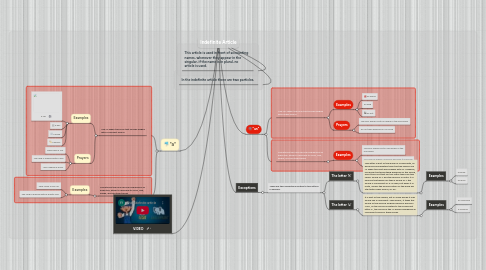
1. "a"
1.1. Use "a" when the noun that follows begins with consonant sound
1.1.1. Examples
1.1.1.1. a car
1.1.1.2. a ball
1.1.1.3. a book
1.1.1.4. a pencil
1.1.2. Prayers
1.1.2.1. They have a car.
1.1.2.2. The dog is playing with a ball
1.1.2.3. I am reading a book.
1.2. Sometimes the noun will be modified by an adjective, either to describe its color, size, shape, among other things.
1.2.1. Examples
1.2.1.1. They have a red car.
1.2.1.2. The dog is playing with a plastic ball.
2. In the indefinite article there are two particles.
3. This article is used in front of accounting names, whenever they appear in the singular, if the name is in plural, no article is used.
4. VIDEO
5. "an"
5.1. Use "an" when the noun that follows begins with vowel sound
5.1.1. Examples
5.1.1.1. an apple
5.1.1.2. an egg
5.1.1.3. an ant
5.1.2. Prayers
5.1.2.1. The boy always eats an apple in the mornings.
5.1.2.2. An ant was walking on my food
5.2. Sometimes the noun will be modified by an adjective, either to describe its color, size, shape, among other things.
5.2.1. Examples
5.2.1.1. The boy always eats a red apple in the mornings.
5.2.1.2. You need a bigger umbrella because it’s raining a lot.
6. Exceptions
6.1. There are two exceptions related to two letters in specific
6.1.1. The letter 'h'
6.1.1.1. This letter is part of the group of consonants, so we would immediately think that we should use "a" when the next word begins with 'h'. However, you know that everything depends on the sound, and it turns out that for this letter there are two cases: sound of 'j' and the famous 'h' mute. It is obvious that when you take a sound of 'j' the sound is consonant so 'a' is used, but when it is mute, usually the pronunciation of the word will start with vowel sound, so 'an' .
6.1.1.1.1. Examples
6.1.2. The letter 'u'
6.1.2.1. It is part of the vowels, but in some words it may sound like a consonant. Specifically, it takes the sound of the second singular person's pronoun "you", so the sound is related to the consonant letter 'y', the sound of the 'u' being considered as consonant sound in these cases.
6.1.2.1.1. Examples
